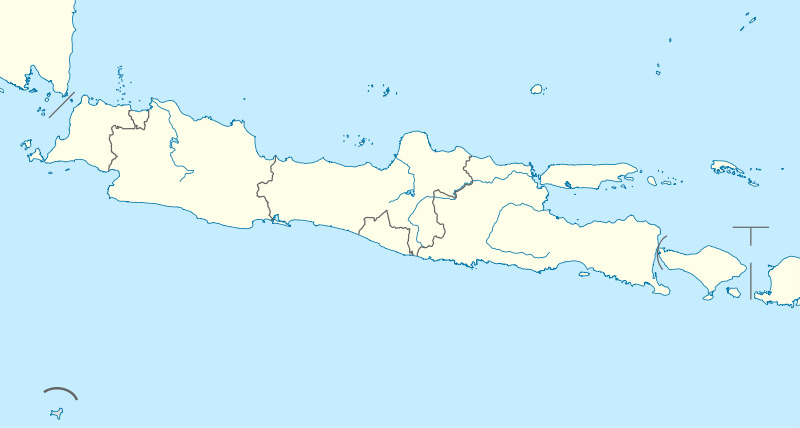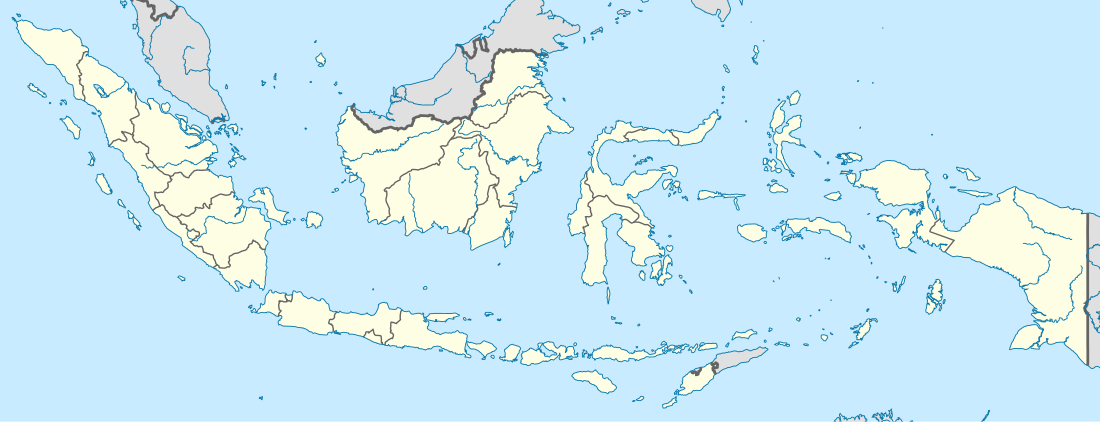Cirebon
Cirebon (Indonesian pronunciation: [t͡ʃirə'bɔn], formerly rendered Cheribon or Chirebon in English) is a port city on the north coast of the Indonesian island of Java. It is located in the province of West Java near the provincial border with Central Java, approximately 297 km (185 mi) east of Jakarta, at 6°43′S 108°34′E. It had a population of 296,389 at the 2010 Census and 307,319 at the 2015 Census; the latest official estimate (as at mid 2020) is 322,322.[2]
Cirebon Caruban Cheribon | |
|---|---|
| Other transcription(s) | |
| • Sundanese | ᮎᮤᮛᮨᮘᮧᮔ᮪ |
| • Javanese | ꦕꦶꦉꦧꦺꦴꦤ꧀ |
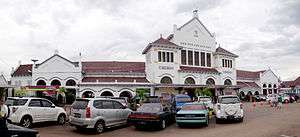  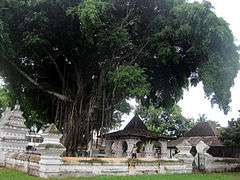   Clockwise, from top left : Cirebon railway station, Kanoman Palace, Former building of the British-American-Tobacco, Krucuk roundabout, Sunan Gunung Jati cemetery site | |
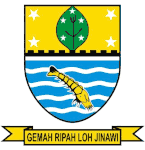 Coat of arms | |
| Nickname(s): | |
| Motto(s): "Gemah Ripah Loh Jinawi" (Serene, Prosperous, Abundantly Fertile) | |
 Location within West Java | |
| Coordinates: 6°42′26″S 108°33′27″E | |
| Country | Indonesia |
| Province | West Java |
| Government | |
| • Mayor | Nasrudin Azis |
| • Vice Mayor | Vacant |
| • Mascot | Amy "Bon Bon" from Cirebon |
| Area | |
| • City | 37.36 km2 (14.42 sq mi) |
| • Metro | 1,021.88 km2 (394.55 sq mi) |
| Population (2020) | |
| • City | 322,322 |
| • Density | 8,600/km2 (22,000/sq mi) |
| • Metro | 2,531,955 |
| • Metro density | 2,500/km2 (6,400/sq mi) |
| [1] | |
| Time zone | UTC+7 (Indonesia Western Time) |
| Area code | (+62) 231 |
| License plate | E |
| Website | cirebonkota.go.id |
| Cirebon | |||||||||||||||||||
|---|---|---|---|---|---|---|---|---|---|---|---|---|---|---|---|---|---|---|---|
| Traditional Chinese | 井裏汶 | ||||||||||||||||||
| Simplified Chinese | 井里汶 | ||||||||||||||||||
| |||||||||||||||||||
The administrative area of Cirebon city proper and its dense metropolitan sprawl into the surrounding regency; the official metropolitan area encompasses this regency as well as the city, and covers an area of 1,021.88 km2 (394.55 sq mi), with a 2010 Census population of 2,363,585; the latest official estimate (as at mid 2020) is 2,531,955.[3]
The seat of a former Sultanate, the city's West and Central Java border location have seen its history influenced by both Sundanese and Javanese culture as well as Arab and Chinese.[4]
History
The sultanate court lies near the modern day city of Cirebon on West Java's north coast. Throughout the 16th and 17th centuries, the sultanate thrived and became the region's center of trade and commerce, as well as served as an Islamic learning and dissemination center. The sultanate split into four royal houses, starting in 1677. Today there are four kratons (palaces) in Cirebon; Keraton Kasepuhan, Kraton Kanoman, Keraton Kacirebonan, and Keraton Keprabonan, each has its own lineage and all are the descendants and remnants of the Cirebon Sultanate.
According to the manuscript Purwaka Caruban Nagari, in 15th century Cirebon started as a small fishing village named Muara Jati. At that time the port of Muara Jati already attracted foreign traders. The port master at that time is Ki Gedeng Alang-Alang whose appointed by the king of Galuh kingdom located inland in Kawali, Ciamis. He moved the port to Lemahwungkuk, 5 kilometres (3.1 mi) southward. As the new settlement leader, Ki Gedeng Alang-Alang was bestowed the title "Kuwu Cerbon" (Cerbon village leader).
A 15th century prince from Pajajaran, Prince Walangsungsang, converted to Islam, and was appointed as the Adipati (Duke) of Cirebon with the title Cakrabumi. He established the new kingdom of Cirebon and declared independence from Sunda and Galuh. The establishment of Cirebon Sultanate marked the first Islamic rule in Western Java, that grew from modest fishing village of Muara Jati to a busy port of Java northern coast.[5] Cirebon grew as one of the independent sultanates under the leadership of Sunan Gunungjati, in the early 16th century. After the Sunda Kingdom collapsed, The Sultanates of Banten and Mataram fought control over Cirebon, which declared its allegiance to Sultan Agung of Mataram. But the later his grandson Amangkurat II ceded the city to the Dutch in the 1677.[6] A treaty in 1705 saw the Cirebon area west of Cisanggarung River became a Dutch protectorate jointly administered by three sultans whose courts rivalled those of Central Java.[6] The Dutch authorities later established the Cirebon Residence (Residentie Tjirebon) which composed of present-day Cirebon, Indramayu, and Kuningan.[7]
During the time of the Dutch "Culture System" a flourishing trade in colonial cash crops attracted many Chinese entrepreneurs and the Chinese influence is still evident in the batik for which Cirebon is famous.[6] Cirebon suffered a famine in 1844, apparently triggered by a combination of drought and the shift from subsistence agriculture to cash crops, particularly indigo and sugarcane, enforced by Dutch's Cultivation system.
Etymology
Being on the border of Sundanese (i.e., West Java) and Javanese (i.e., Central Java) cultural regions, many of Cirebon's residents speak a dialect that is a mix of Sundanese and Javanese, known as Jawareh. It is thought that the word "Cirebon" derives from the Javanese word, caruban, meaning "mixed": a reference to the city's mix of Sundanese, Javanese, Chinese, and Arabic cultural elements. Alternatively, it could be derived from the Sundanese words "ci" (water or river) and "rebon" ("shrimp").[6] (Indeed, the main product of the city is fish including shrimp).
Administrative divisions
Cirebon is divided into five administrative districts (kecamatan), listed below with their populations at the 2010 Census:
- Harjamukti (102,158)
- Kejaksan (42,300)
- Kesambi (70,193
- Lemahwungkuk (52,811)
- Pekalipan (28,927)
Demographics
The city's population was 298,224 at the Indonesia Census of 2010.[8] As with other coastal cities in Indonesia, a large population of ethnic Chinese has flocked into the city as a result of long-term Chinese immigration since the 17th century. Significant suburbs lie within densely populated Cirebon Regency, and the official metropolitan area encompasses this entire regency as well as the city.
| Administrative division | Area (km²) | Population (2010 Census) |
Population (2015 Census) |
Population (2020 Estimate) |
Population density 2020 (/km²) |
|---|---|---|---|---|---|
| Cirebon (Kota) | 37.36 | 296,389 | 307,319 | 322,322 | 8,627.5 |
| Cirebon Regency | 984.52 | 2,067,196 | 2,124,866 | 2,209,633 | 2,244.4 |
| Greater Cirebon | 1,021.88 | 2,363,585 | 2,432,185 | 2,531,955 | 2,477.7 |
Although surrounded by Sundanese-speaking areas in West Java, linguists have stated clearly that Cirebon (and the historically related region of Serang city in Banten Province) are inside its own Cirebonese language area. In addition, this is supported by a large portion of the Cirebon people referring to themselves as "Wong Cirebon" ("Cirebonese people"), and to their language as "Basa Cirebon" ("Cirebonese"). Cirebonese language is related to Javanese and Banyumasan with dialects such as the Jawareh, Plered, and Dermayon.
Culture

Cirebon itself is known as Grage in the Cirebon dialect of Javanese language, which came from the words "Negara Gede", meaning "Great Kingdom." As a port city, Cirebon attracts visitors and settlers from elsewhere in Indonesia and from other nations as well. Cirebon culture was described as Java Pasisiran (coastal) culture, similar to the cultures of Banten, Pekalongan, and Semarang, with notable mixtures of Sundanese, Chinese, Arabic-Islamic, and European influences.
Arts and crafts
Batik textiles from Cirebon, especially Cirebon batik with vivid colors with motifs and patterns, that demonstrate Chinese and local influences, are well known. Chinese influences can be seen in Cirebon's culture, most notably the Cirebon batik Megamendung pattern that resembles Chinese cloud imagery. The Trusmi area is the production center of Cirebon batik. Cirebon Glass Painting is another aspect of Cirebon arts and crafts. The imagery in glass painting is usually derived from wayang theme to Islamic calligraphy.
Performing arts
The Tari Topeng Cirebon, or Cirebon mask dance, is a dance style peculiar to the city. Topeng Cirebon mask dance, inspired by Javanese Panji cycles is one of notable Cirebon traditional dance and quite famous within Indonesian dances.
Cirebon culture is also influenced by Islamic Middle Eastern culture, such as the Burokan tradition where people exhibit the image of buraq — traditionally made from bamboo frame and paper skin, or other materials — in processions around the village accompanied with music. The traditions of the bamboo statues borne in these processions is similar to Sundanese Sisingaan, Betawi Ondel-ondel, or Balinese Ogoh-ogoh processions, yet differ in their Islamic theme. Burokan are usually held during festive occasions such as circumcision or marriage, and are accompanied by popular Cirebon folk songs, such as tarling.'
Tarling is a musical tradition reminiscent of Bandung's kecapi suling music with except that it features guitar, suling (bamboo flute) and voice.[4] The name derived from gitar (guitar), and suling (flute).
Sports
Cirebon is the home town of the PSGJ Cirebon football team, the club plays in the Liga Nusantara. Another team, Cirebon Football Club, the team also plays in the Liga Nusantara is based in the Bima stadium Cirebon. Other popular sports in Cirebon include Futsal.
Court culture
The remnants of Cirebon sultanate; Kasepuhan, Kanoman, Kaprabonan, and Kacirebonan kratons are now run as cultural institutions to preserve Cirebon culture.[9] Each still hold their traditional ceremonies and have become the patrons of Cirebon arts. Some of the royal symbols of Cirebon Sultanate describe their legacy and influences. The banner of Cirebon Sultanate is called "Macan Ali" (Ali's panther) with Arabic calligraphy arranged to resemble a panther or tiger. These indicate both Islamic influence and that of the Hindu Pajajaran Sundanese King Siliwangi's tiger banner. The royal lineage of Cirebon is still well respected and is held in high prestige among the people of Cirebon, although it does not hold real political power anymore,.
The royal carriage of Kasepuhan's Singa Barong and Kanoman's Paksi Naga Liman carriage resembles the chimera of three animals; eagle, elephant, and dragon. These symbolize Indian Hinduism, Arabic Islam, and Chinese influences. The images of Macan Ali, Singa Barong and Paksi Naga Liman are also often featured as patterns in Cirebon batik.
Cuisine
As a coastal city, Cirebon's main industry is fishery. Its products include terasi (shrimp paste), petis, krupuk udang (shrimp crackers) and various salted fish. Cirebon is famous for its good quality salted fishes, such as jambal roti, juhi (salted cuttlefish), rebon and ebi (dried small shrimp). These products are often sought by visitors, especially Indonesian domestic tourists and visitors from other cities, as oleh-oleh (food souvenirs/gift).
Cirebon is also known for its local cuisines and delicacies, such as empal gentong (a kind of meat and offal curry ), Mie Koclok (chicken noodle soup made from coconut milk), Nasi Lengko (rice mixed with bean sprouts, fried tofu, fried tempeh, topped with peanut sauce and soy sauce), Nasi Jamblang (rice of various side dishes), tahu gejrot (fried tofu with ground garlic, chili and shallot, topped with thin and sweet soy sauce), tahu petis (dry fried tofu served with petis dip sauce), Tahu Tek-tek (fried tofu topped with peanut sauce and mixed with vegetables) and ayam panggang (barbecue chicken). Another native food is "Docang" (lontong with sour vegetable soup).
Economy
Cirebon City economy is influenced by its strategic geographical location and by the characteristics of natural resources. Thus, the structure of its economy is dominated by manufacturing, trade, hotels and restaurants, transport and communications and service sectors. Tomé Pires in the Suma Oriental around the year 1513 mentioned Cirebon was one of the trade centers on the island of Java. After Cirebon was taken over by the Dutch East Indies government in 1859, it was designated as a transit port for import-export goods and as a communications route to the political control center for the region in the interior of Java.
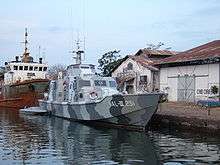
Until 2001, the economic contribution to the City of Cirebon was characterized by processing industry (41.32%), followed by trade, hotels and restaurants (29.8%), transport and communications sector (13.56%), and services sector (6.06%). Other sectors (9.26%) included mining, agriculture, construction, electricity, and gas. Aside from fishery, its harbour, Tanjung Emas, on the Java Sea has been a major hub for timber from Borneo.
Cakrabhuwana Airport in Penggung, Harjamukti subdistrict also serves the TNI-AU. The city lies on Jalur Pantura (Pantai Utara Jawa), a major road on the northern coast of Java that stretches from Anyer, passes through Jakarta, and ends at Surabaya.
Port of Cirebon
The Port of Cirebon was established by the Dutch in 1865, principally as an export point for spices, sugar cane and raw materials from West Java. Warehouses and open storage areas were developed by 1890, and a British American Tobacco cigarette factory was built in the early 20th century.
Port activity is dominated by bulk imports of coal, liquid asphalt and vegetable oils for the West Java hinterland. Until 2002, the port also catered for minor container trade and cruise shipping. In 2006 the port handled 3.27 million metric tons (MT) of trade, more than 90 percent as imports from others Indonesian ports.
Cityscape
Public service
Nearly 93% of the population has been underserved by service water from PDAM Cirebon, the majority of customers in the city's water supply to households (90.37% or as many as 59,006) of the total number of existing connections (65,287).[10]
Health
Since the Dutch East Indies government, Cirebon City has had a hospital named Orange, which unveiled its use on August 31, 1921 and commenced operations from September 1, 1921.
In 2009 in the city of Cirebon has been available about 6 general hospitals, four maternity hospitals, 21 health centers, 15 health centers Maid, 20 Mobile Health Center, and 81 Pharmacies and Drug Stores 31. With the number of medical personnel such as specialist doctors about 94 people, and 116 general practitioners, 37 dentists, 847 nurses and 278 midwives.[11]
Tourism

As one tourist destination in West Java, Cirebon City offers many charms ranging from a historical tour of the royal glory of Islam, the story of the trustees, Complex Sunan Gunung Jati in Mount Sembung about 24 kilometres (15 mi) to the west of the city center, Great Mosque of Cirebon, Taqwa Mosque, temple ancient buildings and relics of Netherlands.
Cirebon is a palace at the same time in the city, namely Keraton Kasepuhan and Kanoman. Everything has architecture a combination of elements culture Islam, China, and Netherlands. Characteristic of the palace buildings are always facing north and there is a mosque nearby. Each palace has square as a gathering place, market and sculpture tiger in park or page forward as a symbol of King Siliwangi, the central character formation Sultanate of Cirebon. Another feature is the plate porcelain original China are so trimmer wall. Some dishes supposedly derived from Europe when Cirebon so port trade center island Java.
Cirebon city park has some of them Waterpark Sunyaragi and Park of Ade Irma Suryani. Water Parks Sunyaragi have technology flow water advanced in his time, the water flow between the terraces where the princess king preening, page grass green where the knight practice, plus tower and room privileged that door was made of curtain water.
Orientation and places

The main boulevard is Jalan Siliwangi. It runs from the train station to the canal via the Pasar Pagi ("Morning Market"). Then the street becomes Jalan Karanggetas along which are most of Cirebon's banks, restaurants, and hotels. There are a number of historic buildings and other key sites in Cirebon, some of them in an advanced state of decay. These include the buildings of the several kratons, the Sang Cipta Rasa Grand Mosque, and the Gua Sunyaragi Park.[12]
Wali Songo, especially Sunan Gunung Jati, is known to have influenced the city's history. Sunan Gunung Jati's grave is located several kilometres outside the city in the Gunung Jati district. There are two temples and a cave system built by two Chinese architects around the 1880s, decorated by Chinese and Western porcelain. The village of Trusmi, about five kilometers outside of Cirebon, has been noted for batik production. Plangon is a habitat of monkeys.
Mt Ceremai, the highest peak in West Java, is a large volcano situated about 40 km (25 mi) to the south of Cirebon. Parks and other tourist spots on the slopes of Mt Ceremai are popular places for groups from Cirebon to visit during weekends to escape from the hotter climate on the coast. The village of Linggajati, near the town of Cilimus, (where the Linggadjati Agreement was signed) is one such place. Public transportation brings tourists and visitors here.
Twin towns – sister cities
Cirebon has sister relationships with a number of towns worldwide:
Notable people
See more at Category:People from Cirebon
Campaign for Cirebon Province
Some of the local political elite in Cirebon and surrounding regencies have campaigned for Cirebon city, together with the regencies of Cirebon, Indramayu, Kuningan and Majalengka to be established as a new province - in the same way as Banten Province was formed by splitting it away from West Java.[13] To be a new province it is required that it should be proposed by at least five regencies. Leaders from four of these administrations have given their consent, but Majalengka Regency has turned down the idea and indicated that it would prefer to stay part of West Java. However, the lack of support from the Majalengka area does not preclude Cirebon city and the other three regencies from continuing to promote the idea.[14]
The potential size and population of this possible Province would be as follows:
| Name | Capital | Area in km2 | Population 2010 Census | Population 2015 Census | Population 2020 Estimate[15] |
|---|---|---|---|---|---|
| Cirebon City | Cirebon | 37.36 | 296,389 | 307,319 | 322,322 |
| Cirebon Regency | Sumber | 984.52 | 2,067,196 | 2,124,866 | 2,209,633 |
| Indramayu Regency | Indramayu | 2,040.11 | 1,663,737 | 1,690,643 | 1,737,624 |
| Kuningan Regency | Kuningan | 1,110.56 | 1,035,589 | 1,054,862 | 1,087,105 |
| Majalengka Regency | Majalengka | 1,204.24 | 1,166,473 | 1,181,701 | 1,210,709 |
| Totals | 5,376.79 | 6,229,384 | 6,359,391 | 6,567,393 |
Gallery
 The port of Cirebon in the 17th century
The port of Cirebon in the 17th century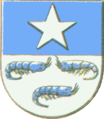 The coat of arms of Cirebon during the Dutch colonial era
The coat of arms of Cirebon during the Dutch colonial era- The main building of the Cirebon City Hall
 The building of Cirebon City Legislatures (DPRD)
The building of Cirebon City Legislatures (DPRD) Gate at Keraton Kasepuhan
Gate at Keraton Kasepuhan Building inside Keraton of Kasepuhan complex
Building inside Keraton of Kasepuhan complex Sunyaragi meditation caves
Sunyaragi meditation caves
 Sculpture in Keraton Kasepuhan
Sculpture in Keraton Kasepuhan Guanyin Temple in Cirebon
Guanyin Temple in Cirebon
See also
- List of cities in Indonesia
Footnotes
- Badan Pusat Statistik, Jakarta, 2020.
- Badan Pusat Statistik, Jakarta, 2020.
- Badan Pusat Statistik, Jakarta, 2020.
- Turner, Peter (November 1995). Java. Melbourne: Lonely Planet. p. 229. ISBN 0-86442-314-4.
- "Profil Sejarah Pemerintahan". Cirebonkota.go.id.
- Turner, Peter (November 1995). Java. Melbourne: Lonely Planet. p. 229. ISBN 0-86442-314-4.
- Tijdschrift voor Nederlandsch-Indië (in Dutch). Lands-Drukkerij. 1874-01-01.
- "Bandung Kota Terpadat di Jawa Barat | nusa | Tempo.co". Tempointeraktif.com. 2010-09-01. Retrieved 2012-05-23.
- Mohamad Katavi, 'Laskar Macan Ali Turunkan Pasukannya dalam Apel Akbar Bhinneka Tunggal Ika', Kilas Cirebon, 30 November 2016.
- "Profile Cirebon" (PDF). Ciptakarya.pu.go.id.
- "Cirebon health data" (PDF). Archived from the original (PDF) on 2013-05-12.
- Nana Rukmana, '52 Cirebon historic buildings in peril', The Jakarta Post, 16 July 2012.
- Arya Dipa, Council urged to endorse formation of Cirebon province', The Jakarta Post, 31 May 2012.
- "Masyarakat Majalengka Tolak Provinsi Baru". February 21, 2012.
- Badan Pusat Statistik, Jakarta, 2020.
Further reading
- Graaf, H. J. de (Hermanus Johannes de Graaf), 1899-(?), "Chinese Muslims in Java in the 15th and 16th centuries: the Malay Annals of Semarang and Cerbon / translated and provided with comments by H. J. de Graaf and Theodoor Gautier Thomas Pigeaud; edited by M.C. Ricklefs. Publisher: [Melbourne] | Monash University, 1984. Description: xiii, 221 p. | folded map ; 21 cm. ISBN 0-86746-419-4 | Series: Monash papers on Southeast Asia; no. 12
- Sulendraningrat, P.S. (1985). Sejarah Cirebon. Jakarta: Balai Pustaka. OCLC 246515112.
